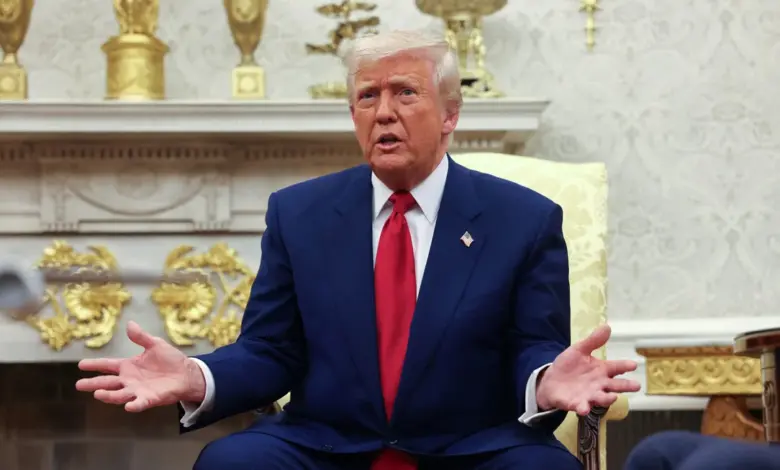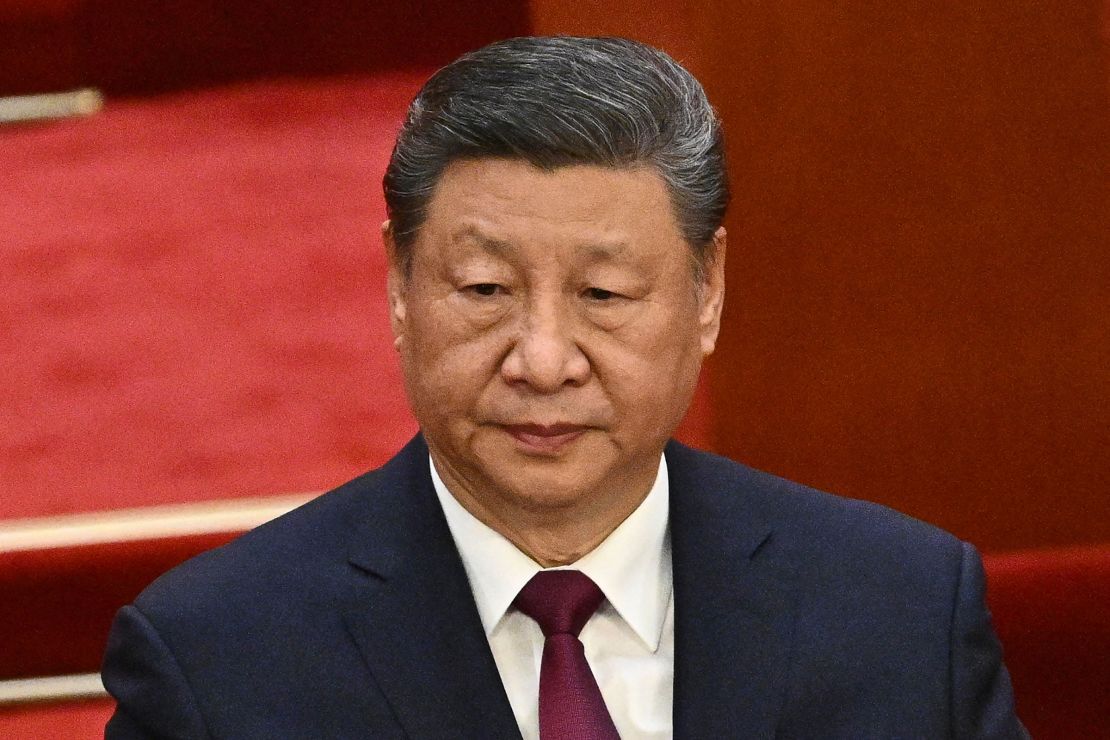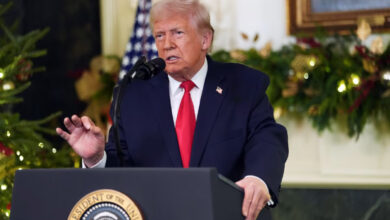
President Donald Trump is heading into another volatile week of his trade wars facing an urgent need to de-escalate the clash he ignited with China before it inflicts deep damage on the US economy.
Chinese President Xi Jinping is so far declining US pressure to call his American counterpart to seek a “deal” after the United States imposed 145 percent tariffs on its superpower rival, setting off a long-feared direct confrontation.
This leaves Trump repeatedly assuring Americans that his “great relationship” with the Chinese leader will head off a crisis but unable to initiate talks in a standoff that risks tanking stock markets again and imposing real hardships on Americans.
Despite the uncertainty, Trump is putting on a show of relishing multiple fights he set off, and he lapped up a standing ovation as he took a seat cage-side at a UFC mixed martial arts event in Florida on Saturday night. The president, who styles himself as an ultimate political fighter, told reporters his reception was “somewhat legendary” and showed that “we’re doing a good job.”
But the president’s conflict with China is a real-world showdown with far higher stakes.
The impasse is so serious because the US and Chinese economies are intricately entwined. The US relies on China for consumer electronics; rare earth minerals used in the manufacture of electric vehicles and for military applications and robotics; pharmaceuticals used in lifesaving medicines; and more basic staples of daily life, including clothing and shoes. US exports of produce like soybeans and sorghum to China are vital to the livelihoods of American farmers, but the tariffs imposed by both sides are so prohibitive that trade may effectively grind to a halt.
Both sides could suffer terribly in a full-blown trade war, and US consumers could be hit by shortages and surging prices. But some experts believe that China, owing to its authoritarian system of government, would be willing to impose more pain on its populace to avoid losing what could be a defining struggle with the US.
Trump’s capacity to play the long game was called into question when he suddenly paused reciprocal tariffs on dozens of nations last week for 90 days after bond market sell-offs began to hint at a developing financial crisis. That climbdown will have been carefully watched in Beijing. And in seeking to ease one sticky situation, Trump exacerbated another — lashing out at China with his 145 percent tariffs in an apparent effort to save face.
As the chaos worsens, the White House added more confusion Friday night, exempting imports of Chinese-made smartphones and computers from the top tariff rate in an apparent acknowledgment that sky-high levies on those items could hammer the tech industry and US consumers.
But on Sunday, the administration insisted that such products would still be subject to new tariffs at a lower level in the coming weeks, raising further questions about its apparently unplanned and knee-jerk stances, which have repeatedly scared markets.
“NOBODY is getting ‘off the hook’ for the unfair Trade Balances, and Non Monetary Tariff Barriers, that other Countries have used against us, especially not China which, by far, treats us the worst!” Trump wrote Sunday on Truth Social. “There was no Tariff ‘exception’ announced on Friday. These products are subject to the existing 20 percent Fentanyl Tariffs, and they are just moving to a different Tariff ‘bucket.’ The Fake News knows this, but refuses to report it,” he went on.
Confusion in the administration’s messaging
As it has several times, the administration is insisting that its sudden moves and inconsistent messaging were part of the plan all along.
“This is just another great example of how President Trump had a detailed plan from the beginning that’s being executed exactly as directed,” White House deputy chief of staff Stephen Miller said on Fox News’ “Sunday Morning Futures.” He explained the administration’s thinking that such items are vital to US national security and thus required different treatment for “reshoring” factories that make them.
The administration insists its strategy is working, arguing that scores of countries included in the now-paused reciprocal tariffs have rushed to offer stunning deals to Trump to escape American pressure.
The White House is now applying similar logic to China, betting that the might of the US economy will force Xi to offer concessions on long-held grievances that include concerns over market access, intellectual property theft and a vast trade imbalance that Trump insists is proof Beijing is ripping off Washington.
“It’s kind of almost a two-world system. There’s a process about China, and that’s very, very nascent … and then the process for everybody else,” Kevin Hassett, director of the White House National Economic Council, told CNN’s Jake Tapper on “State of the Union” on Sunday. “So the process for everybody else is orderly, it’s clear. People are coming to town with great, great offers.”

The Trump approach is risky, and it may fail to take into account the complexities of the US-China relationship and the political dynamics in Beijing. This is because Xi’s attempt to turn his country into a dominant great power is founded in a conceit that the US and other Western powers have historically adopted colonial-style policies to suppress Chinese influence and deprive it of its rightful place in the world. This makes it almost impossible for Xi to be seen as caving to what China regards as US bullying.
Still, the administration has dismissed warnings that China can hurt the US as badly as Washington can hurt it. “They’re playing with a pair of twos,” Treasury Secretary Scott Bessent said last week on CNBC. He argued that since the US exports only a fifth of the total value of goods Beijing sends to the US, its economy would come off worse in a tit-for-tat trade war.
That reasoning and Trump’s confidence that his typical brinksmanship and raising of the stakes to intolerable levels, which he honed as a real estate mogul in New York, will be tested in the days to come.
If Trump does manage to reframe the US trading relationship with China, he will claim a significant achievement in a new era of Washington relations with Beijing. For years, presidents of both parties reasoned that by liberalizing China’s previously controlled economy, the US could usher its rival into the global rule-based trading system and promote political reforms inside the country. But that calculus began to change at the end of the Obama administration, and Xi’s nationalistic rule sharpened the economic and geopolitical showdown between the two sides.
Trump ‘has the ball’
Trump has argued with some justification that expanded trade with China has built a superpower foe that US leaders in both parties now regard as the premier threat to US national security and global power. At the same time, however, cheap clothes and consumer goods such as iPhones have massively improved the material circumstances of millions of Americans, even as globalization has hollowed out US manufacturing heartlands and left a trail of social blight.
Despite the rising tensions and more nervousness to come on the stock markets this week, Trump’s aides on Sunday defended the president’s approach, which risks tipping into recession an economy that was humming along when he took office less than three months ago.
“This is unfolding exactly like we thought it would in a dominant scenario,” White House trade adviser Peter Navarro said on NBC’s “Meet the Press.” He added: “We’ve got 90 deals in 90 days possibly pending here.”
That kind of success rate in negotiating trade deals, which normally take years to clinch, would be remarkable — one reason why many analysts don’t take the administration’s bombast about offers from foreign nations at face value. The possibility remains that countries such as Japan, India and South Korea, as well as the European Union, will offer Trump splashy concessions he can claim as a big win while they do not fundamentally change bilateral trading relationships.
That would mean one of Trump’s core justifications for the tariff war — remaking American manufacturing — would not be achieved. Cosmetic wins for Trump would also fail to justify the trillions of dollars his actions have wiped off global stock markets and the losses he’s inflicted on millions of Americans’ retirement accounts.

There are growing signs that the president’s chaotic economic management is depressing his political standing in a way that will be particularly sensitive for Republican lawmakers in the year before the midterm elections.
A new CBS poll Sunday showed that the president’s approval ratings over his handling of the economy and inflation have dipped. Some 44 percent of respondents approve and 56 percent disapprove of his performance on the economy, while only 40 percent approve and 60 percent disapprove on his handling of inflation. And 75 percent expect at least short-term price spikes due to tariffs, while 48 percent expect long-term increases.
These are shaky numbers considering that the real impact of tariffs is yet to be felt by consumers in terms of rising prices. And Trump’s bet is particularly hazardous given that his promise to lower the costs of food and housing was at the center of his win over Democratic Vice President Kamala Harris last November.
Despite the tense times, one of Trump’s loudest boosters in the Cabinet, Commerce Secretary Howard Lutnick, remains bombastic.
“Donald Trump has the ball. I want him to have it. He’s the right person with it,” Lutnick said on ABC News’ “This Week.” “He knows how to play this game. He knows how to deal with President Xi. This is the right person for the right role, and I am confident this is going to work out with China.”
Yet the mystique of Trump as a master dealmaker, which has been more central to the president’s political appeal than anything else, has never faced a tougher test.




